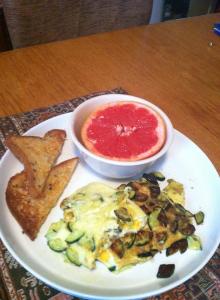


Frankly, I get a little shaken up when I see gutted pumpkins on people’s doorsteps. It seems we only use squash as a decorative medium or as part of a toddler’s playground called a pumpkin patch. Do we ever teach our children to eat it? Only in America do we have the audacity to use good, edible food for decoration. OK, I’m stepping off my soapbox.
Zucchini. Not as festive as the pumpkin, and often overlooked. It seems the only thing we do with it is mix it in with sugar and flour and make zucchini bread. As if we needed another empty carb during the holidays? So I decided to experiment and use it. Guess what? Zucchini is easy! Here’s what I did:
DAY 1: Zucchini and Tofu Tacos DAY 2: Zucchini Omelette

TIP: Always add colorful foods to your dish!

TIP: Always add “live” foods to your plate (i.e., zucchini & grapefruit).
DAY 3: Zucchini Breakfast Burritos
DAY 4: Zucchini Butter with Sweet Potato!
I hope this post was inspiring. Shoot me back some healthy recipes of your own!
As I sit in the fallout of tortured “geniuses” before me, I reflect on how we, in an effort to feel safe, separate our art from our daily living.
I watched the documentary, Salinger, on PBS’ American Masters. As an actor, I’m fascinated with human behavior. Salinger was – is – a writing phenom, but what interested me was how he wrote as opposed to what he wrote. Not long after Catcher in the Rye was published, he moved from Manhattan to Cornish, New Hampshire, an idyllic, sacred place “away from it all”. But unlike most writers, who use their sacred places with scheduled intent, he used it (and his windowless office) non-stop, and it became a place for him to hide. I see obvious parallels to this and the abuse of natural drugs. Originally intended as medicinal and sacred, plant based drugs are now used as modern day transports to “hiding places”.
In the five main areas of life – career, relationships, health, finances and spirituality – artists tend to focus on only one: career. I want to pile all of these areas in the same car, and take a road trip through art. I imagine good health supporting my career. I imagine frequent, in-person contact with loved ones fueling my career. I can see a strong spiritual base inspiring my creativity, and a good financial flow that keeps me abundant in art supplies. Being a loner is considered cool. Being career driven at the expense of personal relationships is deemed admirable (unless you’re a woman). Being an outsider, being separate is considered synonymous with being a genius. It’s also synonymous with being a serial killer. We are not separate. We are not our art. Our art is simply an expression of who we are. And who we are is the sum of all of our parts.